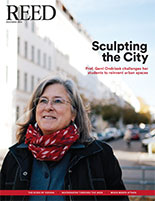
IRIS login | Reed College home Volume 94, No. 4: December 2015
The Art of the Conference
I was the lonely, only son of an Air Force command pilot when I attended Reed from 1965–69 as Vietnam and the anti-war movement were heating up. Lacking confidence and prone to reticence in large groups, I benefited in conferences by listening intently, but rarely participating. Owing to my isolation, the system was somewhat wasted on me at the time. The atmosphere in the room felt too judgmental toward my still developing, fragile world-view, so I got more from casual conversation and through personal relationships outside class. My professors were at once charismatic, energetic, insightful, well-versed, highly skilled verbally and some, even wise. Nonetheless, no one made me feel the way reading the dialogues of Plato did.
The feature on “The Art of the Conference” in the September issue touches on ‘cultivating inclusiveness’—i.e. overcoming ‘feeling silenced’, maintaining an ‘encouraging environment’, providing a ‘forum for all voices’, balancing the ‘overly talkative’ student with those who rarely speak—but only tangentially. Prof. Minardi comes close when she talks about arranging the furniture differently, or dividing the class into smaller groups. Prof. Makley’s focus on ‘creating space’ for marginalized participants in such ‘high-stakes performances’ is right on. The group experience needs to be one of, not merely being ‘simultaneously present’, but actually enjoying shared time together. As she so aptly puts it, content and subject matter become less relevant when our ‘intellectual personae’ are on display. Getting to know each other by name, feeling supported emotionally without fear of error, not to mention mutual trust and respect, are basic to any meaningful conference.
After working 30 years as a psychologist with groups of young people, one thing I have learned is that, before the “art” of the conference can be practiced effectively, first the “science” of group dynamics must be applied. Here, there are a few simple, well-established rules to help facilitate the right conditions. First, no more than eight (8) people in a group; whenever that limit is exceeded, communications begin to break down, shy students withdraw and more assertive ones dominate. Next, comes the “elevator effect,” i.e. silence always prevails in a densely crowded elevator. A convenient formula for this is roughly 50 sq. ft. per person, so an adequate floor area for an ideal group would be… well, you do the math!
Regarding your cover story on successful conferences [September 2015]: I want a do-over. At least on my Hum 110 and Hum 220 conferences. I was really not listening in 1970 and ’71. Your article is profound and available at once, and will affect any training I do from now on.

LATEST COMMENTS
steve-jobs-1976 I knew Steve Jobs when he was on the second floor of Quincy. (Fall...
Utnapishtim - 2 weeks ago
Prof. Mason Drukman [political science 1964–70] This is gold, pure gold. God bless, Prof. Drukman.
puredog - 1 month ago
virginia-davis-1965 Such a good friend & compatriot in the day of Satyricon...
czarchasm - 4 months ago
John Peara Baba 1990 John died of a broken heart from losing his mom and then his...
kodachrome - 7 months ago
Carol Sawyer 1962 Who wrote this obit? I'm writing something about Carol Sawyer...
MsLaurie Pepper - 8 months ago
William W. Wissman MAT 1969 ...and THREE sisters. Sabra, the oldest, Mary, the middle, and...
riclf - 10 months ago